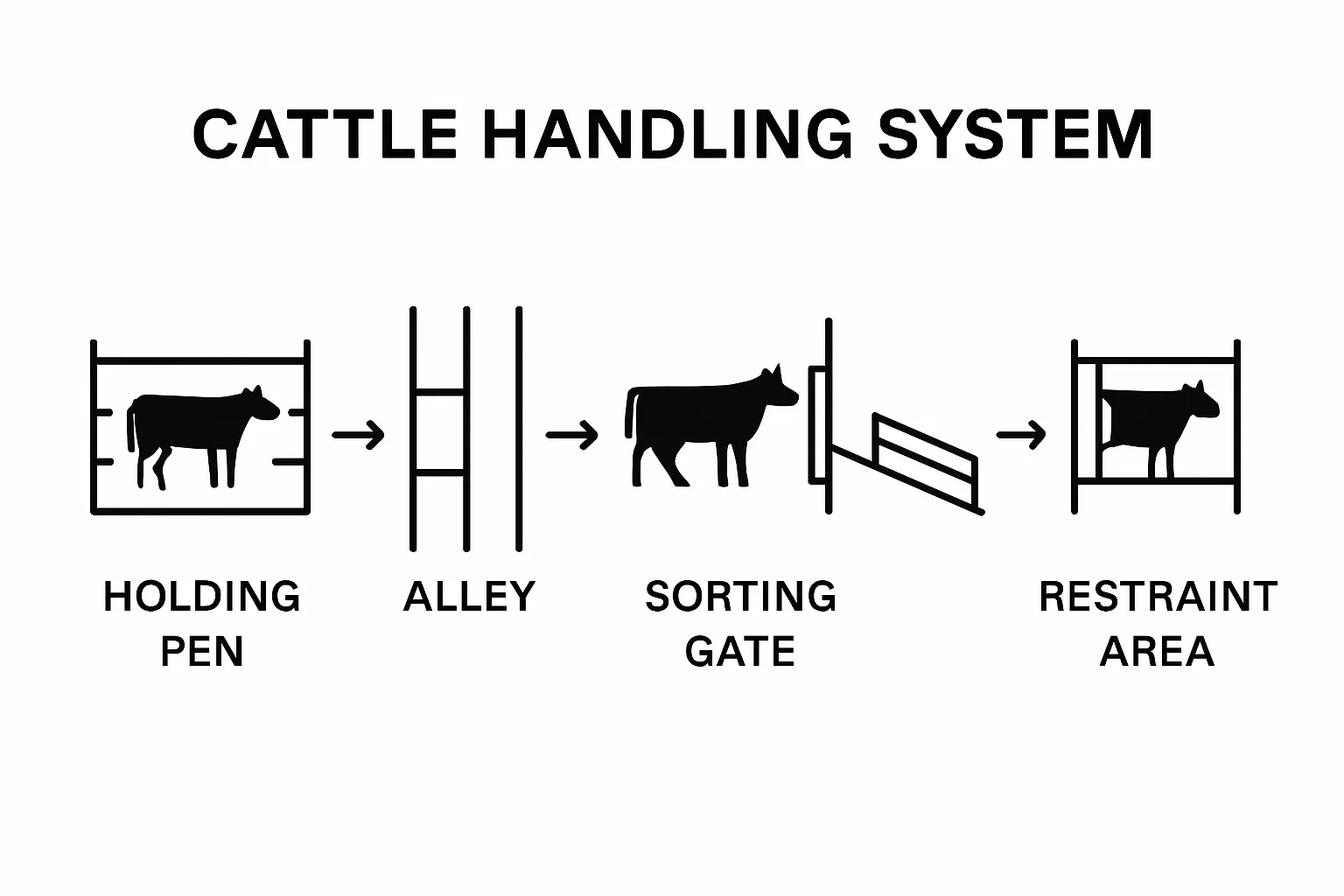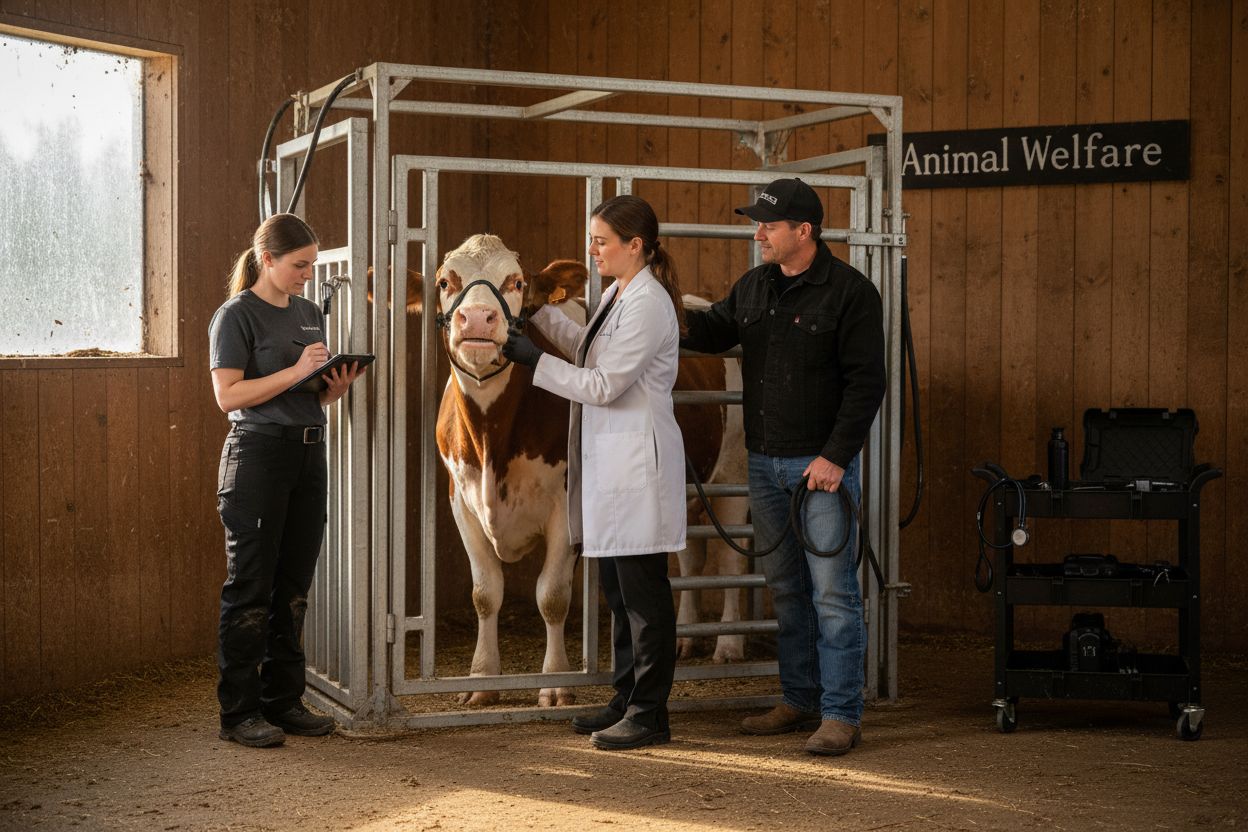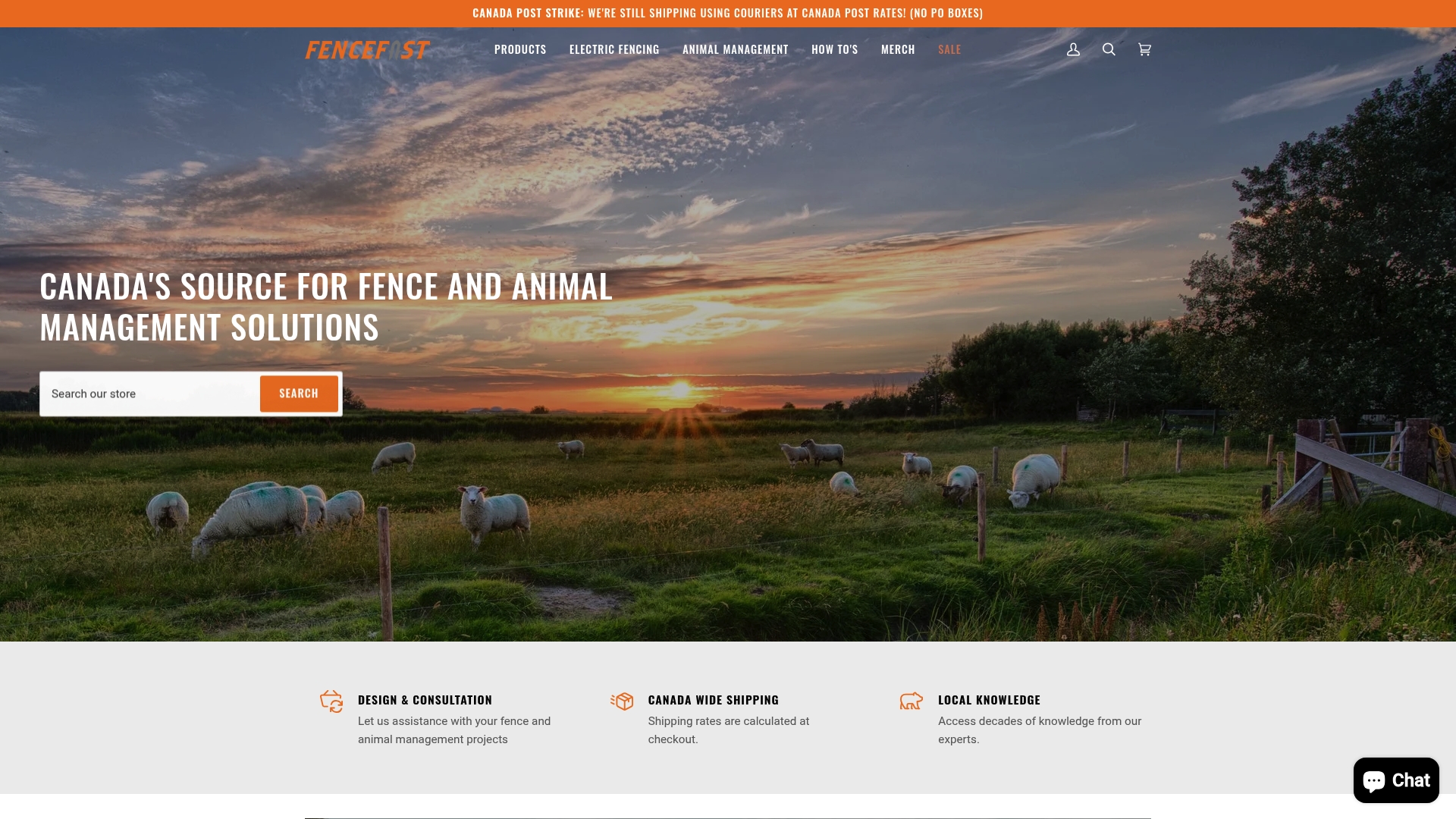Cattle handling systems are at the heart of every successful ranch and they do far more than just move livestock from point A to point B. While most people think these setups are just a collection of gates and chutes, the truth is surprising. A well-designed system can cut animal stress and injuries by more than half according to leading veterinary studies. That kind of impact turns basic equipment into a gameplan for safer handling, healthier cattle, and bigger profits in ways you probably would not expect.
Table of Contents
- What Are Cattle Handling Systems?
- The Importance Of Effective Cattle Handling
- Key Components Of Cattle Handling Systems
- How Cattle Handling Systems Enhance Animal Welfare
- Real-World Applications And Best Practices
Quick Summary
| Takeaway | Explanation |
|---|---|
| Design for animal behavior | Cattle prefer curved pathways to reduce stress during movement. Design systems considering their natural tendencies for smoother handling. |
| Focus on low-stress techniques | Implement consistent handling methods that prioritize calm interactions, improving animal welfare and operational efficiency. |
| Regular training is essential | Continuously train staff on low-stress handling methods and equipment maintenance to enhance cattle management practices. |
| Integrate technology wisely | Utilize technological innovations like behavioral monitoring for improved insights into animal health and handling efficiency. |
| Prioritize infrastructure quality | Adequate design and maintenance of handling systems help minimize injuries and stress, benefiting both livestock and handlers. |
What Are Cattle Handling Systems?
Cattle handling systems are comprehensive infrastructure and design frameworks specifically engineered to manage, control, and safely move livestock during various agricultural operations. These systems represent critical components in modern ranching and animal management, designed to minimize stress for both animals and handlers while maximizing operational efficiency.
Core Components of Cattle Handling Systems
A well-designed cattle handling system integrates multiple structural elements that work together seamlessly. Learn more about essential livestock infrastructure that supports effective animal management. These core components typically include:
- Corral pens with strategic layout and sizing
- Loading chutes with proper angle and width
- Sort gates and alleyways
- Working platforms and restraint areas
- Crowd gates for controlled movement
Purpose and Functional Design
The primary objective of cattle handling systems is to create a controlled environment that facilitates routine management tasks such as vaccination, weighing, sorting, and health inspections. Professional ranchers understand that these systems must be designed with animal behavior and psychology in mind. Cattle naturally prefer curved pathways that prevent them from seeing potential exit points, which reduces anxiety and makes movement smoother.
By implementing thoughtful design principles, handlers can significantly reduce animal stress, minimize potential injury risks, and improve overall livestock management efficiency. The most effective cattle handling systems consider factors like animal movement patterns, visual barriers, surface textures, and ergonomic considerations for both animals and human operators.
A strategic cattle handling system transforms what could be a challenging process into a streamlined, low-stress experience that prioritizes animal welfare and operational productivity.
Below is a table summarizing the key components commonly found in effective cattle handling systems and their primary functions.
| Component | Purpose |
|---|---|
| Corral Pens | Provide initial holding and sorting space for cattle |
| Loading Chutes | Facilitate safe transfer onto trucks or between enclosures |
| Sort Gates | Allow handlers to direct cattle into specific areas |
| Working Alleys | Guide cattle smoothly towards chutes or restraint areas |
| Restraint Areas | Secure cattle for medical procedures and inspections |
| Crowd Gates | Control and direct flow of cattle within pens and alleys |
The Importance of Effective Cattle Handling
Effective cattle handling is a critical aspect of agricultural management that directly impacts animal welfare, productivity, and overall farm economic performance. Learn more about livestock management strategies that complement good handling practices.
Economic and Animal Welfare Implications
The significance of proper cattle handling extends far beyond simple operational logistics. Research from the National Institutes of Health indicates that poor handling techniques can lead to substantial economic losses and animal welfare challenges. Inefficient handling methods create multiple negative outcomes:
- Increased stress levels in cattle
- Reduced weight gain and meat quality
- Higher risk of injury for both animals and handlers
- Diminished reproductive performance
- Compromised immune system responses
Psychological and Behavioral Considerations
Cattle are sensitive animals with complex behavioral patterns. Understanding their psychological responses is fundamental to developing effective handling strategies. Cattle inherently prefer predictable, low-stress environments where they can move naturally and feel secure. Handlers who recognize and respect these behavioral traits can create management systems that minimize anxiety and promote cooperative animal movement.
Professional livestock managers understand that every interaction represents an opportunity to build trust and reduce potential resistance. By implementing calm, consistent handling techniques, ranchers can transform potentially stressful management procedures into smooth, efficient processes that benefit both the animals and the agricultural operation.
Ultimately, effective cattle handling is not just a technical skill but a comprehensive approach that balances scientific understanding, animal psychology, and practical agricultural management techniques.
This table compares the economic and animal welfare implications of poor versus effective cattle handling methods, as discussed in the article.
| Handling Approach | Animal Stress | Injury Risk | Meat Quality | Reproductive Performance | Operational Efficiency |
|---|---|---|---|---|---|
| Poor Handling | High | High | Reduced | Decreased | Low |
| Effective Handling | Low | Low | Maintained | Improved | High |
Key Components of Cattle Handling Systems
Cattle handling systems consist of sophisticated infrastructure designed to facilitate safe, efficient livestock management. Check out our guide on selecting the best livestock fencing to complement your handling system design.
Structural Elements and Design Principles
According to Texas A&M AgriLife Extension, successful cattle handling systems integrate several critical structural components that work harmoniously to minimize animal stress and maximize operational efficiency:
- Holding pens with appropriate space and configuration
- Loading chutes with safe entry and exit points
- Working alleys with curved design to facilitate smooth animal movement
- Sorting gates for precise livestock management
- Restraint areas for medical procedures and inspections

Functional Design Considerations
The effectiveness of a cattle handling system depends on understanding animal behavior and implementing ergonomic design principles. Each component must be carefully engineered to support natural cattle movement patterns. This means creating pathways that feel intuitive and non-threatening to the animals, with considerations such as:
- Eliminating visual distractions that might cause anxiety
- Maintaining consistent surface textures and gradients
Professional ranchers recognize that a well-designed handling system is more than just physical infrastructure. It represents a comprehensive approach to animal management that prioritizes safety, efficiency, and low-stress interactions between handlers and livestock.
By investing in thoughtfully constructed cattle handling systems, agricultural professionals can significantly improve animal welfare, reduce potential injuries, and enhance overall operational productivity.
How Cattle Handling Systems Enhance Animal Welfare
Cattle handling systems play a pivotal role in protecting and improving livestock well-being through scientifically designed infrastructure that minimizes stress and promotes natural animal behavior. Explore our guide on managing livestock environments to understand comprehensive animal care strategies.
Psychological and Physiological Stress Reduction
Research from the American Veterinary Medical Association demonstrates that strategic handling systems directly impact cattle stress levels. Properly designed facilities can significantly mitigate negative physiological responses by creating environments that align with cattle’s natural movement and behavioral instincts:
- Reducing sudden environmental changes
- Minimizing unexpected loud noises
- Creating predictable movement pathways
- Eliminating visual barriers that trigger anxiety
- Providing consistent, smooth surface transitions
Design Principles Supporting Animal Comfort
Effective cattle handling systems incorporate nuanced design elements that address both physical and psychological animal welfare requirements. This holistic approach recognizes that cattle are sensitive creatures with complex emotional responses. By engineering spaces that feel intuitive and non-threatening, ranchers can transform potentially stressful management procedures into calm, controlled interactions.

The most advanced handling systems integrate principles of animal behavior science, considering factors like sight lines, movement patterns, and environmental stimuli. These designs help prevent panic responses, reduce potential injury risks, and create an atmosphere of predictability that allows cattle to move through management processes with minimal distress.
Ultimately, superior cattle handling systems represent a commitment to ethical livestock management, balancing operational efficiency with genuine respect for animal well-being.
Real-World Applications and Best Practices
Cattle handling systems transcend theoretical design, representing practical solutions that ranchers and agricultural professionals implement to optimize livestock management. Learn about advanced rotational grazing techniques that complement effective handling strategies.
Practical Implementation Strategies
According to the National Cattlemen’s Beef Association, successful cattle handling requires a comprehensive approach that integrates infrastructure, technological tools, and human expertise. Effective implementation involves several critical considerations:
- Conducting regular staff training on low-stress handling techniques
- Maintaining and regularly inspecting handling equipment
- Designing flexible systems that accommodate different cattle ages and sizes
- Implementing consistent movement and interaction protocols
- Utilizing technology for tracking and monitoring animal behavior
Technology and Innovation in Cattle Management
Modern cattle handling systems increasingly incorporate advanced technological solutions that enhance traditional infrastructure. Innovations such as digital tracking, automated sorting gates, and behavioral monitoring systems are revolutionizing how ranchers interact with and manage their livestock. These technologies provide unprecedented insights into animal health, movement patterns, and stress indicators, enabling more precise and humane management approaches.
The most successful agricultural operations recognize that effective cattle handling is not just about physical infrastructure but about creating a holistic ecosystem that prioritizes animal welfare, operational efficiency, and continuous improvement. By combining thoughtful design, ongoing education, and technological innovation, ranchers can develop cattle handling systems that not only meet immediate operational needs but also adapt to evolving agricultural practices and animal welfare standards.
Ready to Build a Safer, More Efficient Cattle Handling System?
Managing cattle movement and handling safely is never simple. The article highlighted how the right infrastructure and components can reduce animal stress, minimize injuries, and boost ranch productivity. If you worry about cattle stress or struggle with outdated handling setups, you are not alone. Modern cattle operations need reliable equipment from sturdy fencing to easy-to-use animal monitoring tools. Without these, even simple tasks can become stressful and inefficient, impacting your bottom line and your animals’ well-being.

Take the guesswork out of livestock care. Visit FenceFast.ca to find fencing solutions, electric gates, and animal management supplies that perfectly complement the best practices discussed here. Whether you need to secure your corral, upgrade monitoring with our livestock management tools, or explore tips like those in our article on 10 essential tips for the best cow fence, you will find expert support and high-quality products in one place.
Start building a handling system that improves animal welfare and streamlines your ranch. Act now to give your cattle the care they deserve and your operation the upgrade it needs. Shop today or contact an expert at FenceFast.ca to start planning your next step.
Frequently Asked Questions
What are cattle handling systems?
Cattle handling systems are designed infrastructures tailored to manage and safely move livestock, aiming to reduce stress for both animals and handlers while enhancing operational efficiency in ranching and animal management.
What are the core components of an effective cattle handling system?
Effective cattle handling systems typically include holding pens, loading chutes, sorting gates, working alleys, and restraint areas, all designed to facilitate smooth, low-stress animal movement during management tasks.
How do cattle handling systems improve animal welfare?
Cattle handling systems enhance animal welfare by creating environments that minimize stress through thoughtful design, which aligns with cattle’s natural behaviors, reduces anxiety, and prevents injuries during handling procedures.
What role does technology play in modern cattle handling systems?
Modern cattle handling systems are increasingly incorporating technology such as digital tracking and automated sorting gates to provide insights into animal behavior and health, which leads to more efficient and humane livestock management.
